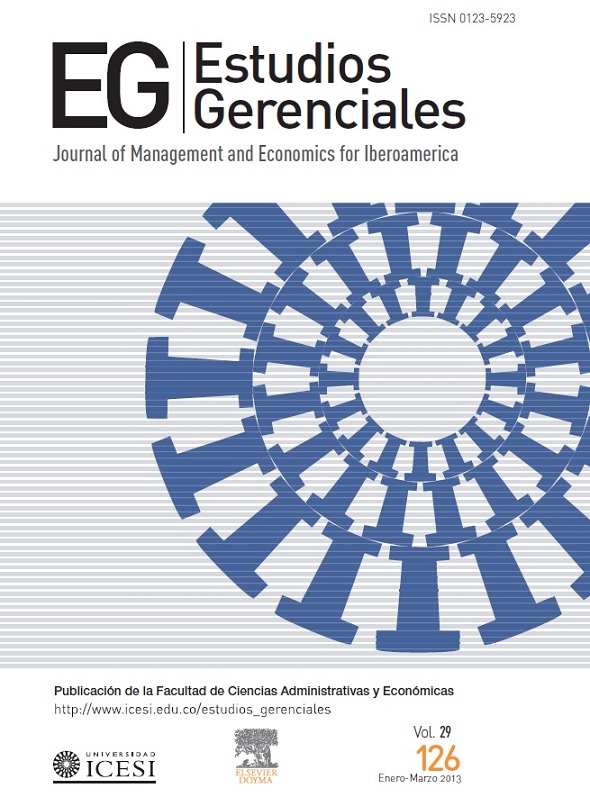Valor en riesgo: evaluación del desempeño de diferentes metodologías para 5 países latinoamericanos
DOI:
https://doi.org/10.1016/S0123-5923(13)70018-4Keywords:
Valor en Riesgo, Backtesting, Aproximación Paramétrica, Aproximación no paramétrica, América Latina.Abstract
Este documento evalua el comportamiento de veinte diferentes metodos (parametrico, no parametricos y semi-parametricos) para estimar el VaR (Valor en Riesgo) de un portafolio representativo para 5 paises latinoamericanos (Argentina, Brasil, Chile, Colombia y Peru). Despues de encontrar la aproximacion que mejor captura el nivel de riesgo seleccionado para cada portafolio, se encontro que los modelos no-parametricos de simulacion historica y semi-parametricos corresponde a la mejor medida de riesgo para todos los países de la muestra.
Downloads
References
Alonso, J. C. & Arcos, M. A. (2005). Cuatro Hechos Estilizados de las series de rendimientos: Una ilustración para Colombia. Mimeo.
Alonso, J. C. & Berggrun, L. (2010). Introducción al análisis de riesgo financiero. Colección Discernir. Serie Ciencias Administrativas y Económicas. Cali: Universidad Icesi.
Barone-Adesi, G. & Giannopoulos, K. (2001). Non-parametric VaR Techniques: Myths and Realities. Economic Notes, 30(2), 167-181.
Barone-Adesi, G., Giannopoulos, K. & Vosper, L. (1999). VaR without correlations for nonlinear Portfolios. Journal of Futures Markets, 19, 538-602.
Bollerslev, T. (1986). Generalized autoregressive conditional heteroscedasticity. Journal of Econometrics, 31, 307-327.
Christoffersen, P. (1998). Evaluating interval forecasts. International Economic Review, 39, 841-862.
Cont, R. (2001). Empirical Properties of Asset Returns: Stylized Facts and Statistical Issues. Quantitative Finance, 1(2), 223-236.
Cross, F. (1973). The behavior of stock prices on fridays and mondays. Financial Analyst Journal, 67-69.
Ding, Z., Granger C. W. J. & Engle, R. F. (1993). A Long Memory Property of Stock Market Returns and a New Model. Journal of Empirical Finance, 1, 83-106.
Engle, R. F. (1982). Autoregressive conditional heteroscedasticity with estimates of the variance of United Kindom inflation. Econometrica, 31, 987-1007.
French, K. (1980). Stock returns and the weekend effect. Journal of Financial Economics, 8, 55-69.
Gibbons, M., & Hess, P. (1981). Day of the week effects and asset returns. Journal of Business, 54, 579-596.
Guermat, C. & Harris, R. (2002). Forecasting value at risk allowing for time variation in the variance and kurtosis of portfolio returns. International Journal of Forecasting, 18, 409-419.
Hull, J. & White, A. (1998.). Incorporating volatility updating into the historical simulation method for VaR. Journal of Risk, 1, 5-19.
Keim, D. B. & Stambaugh, F. (1984). A further investigation of weekend effects in stock returns. Journal of Finance, 819-840.
Kupiec, P. H. (1995). Techniques for verifying the accuracy of risk measurement models. The Journal of Derivatives, 3, 73-84.
Lakonishok, J. & Levi, M. (1982). Weekend effect in stock return: a note. Journal of Finance, 37, 883-889.
López, J. A. (1998). Methods for evaluating Value-at-Risk estimates. Federal Reserve Bank of New York. Economic Policy Review, (2), 3-17.
Rivera, D. M. (2009). Modelación del efecto del día de la semana para los índices accionarios de Colombia mediante un modelo Star Garch. Revista de Economía del Rosario, 12, 1-24.
Rogalski, R. J. (1984). New findings regarding day-of-the-week returns over trading and non-trading periods: a note. Journal of Finance, 1603-1614.
Downloads
Published
Issue
Section
License
Articles are the sole responsibility of their authors, and will not compromise Icesi’s University principles or policies nor those of the Editorial Board of the journal Estudios Gerenciales. Authors authorize and accept the transfer of all rights to the journal, both for its print and electronic publication. After an article is published, it may be reproduced without previous permission of the author or the journal but the author(s), year, title, volume, number and range of pages of the publication must be mentioned. In addition, Estudios Gerenciales must be mentioned as the source (please, refrain from using Revista Estudios Gerenciales).








